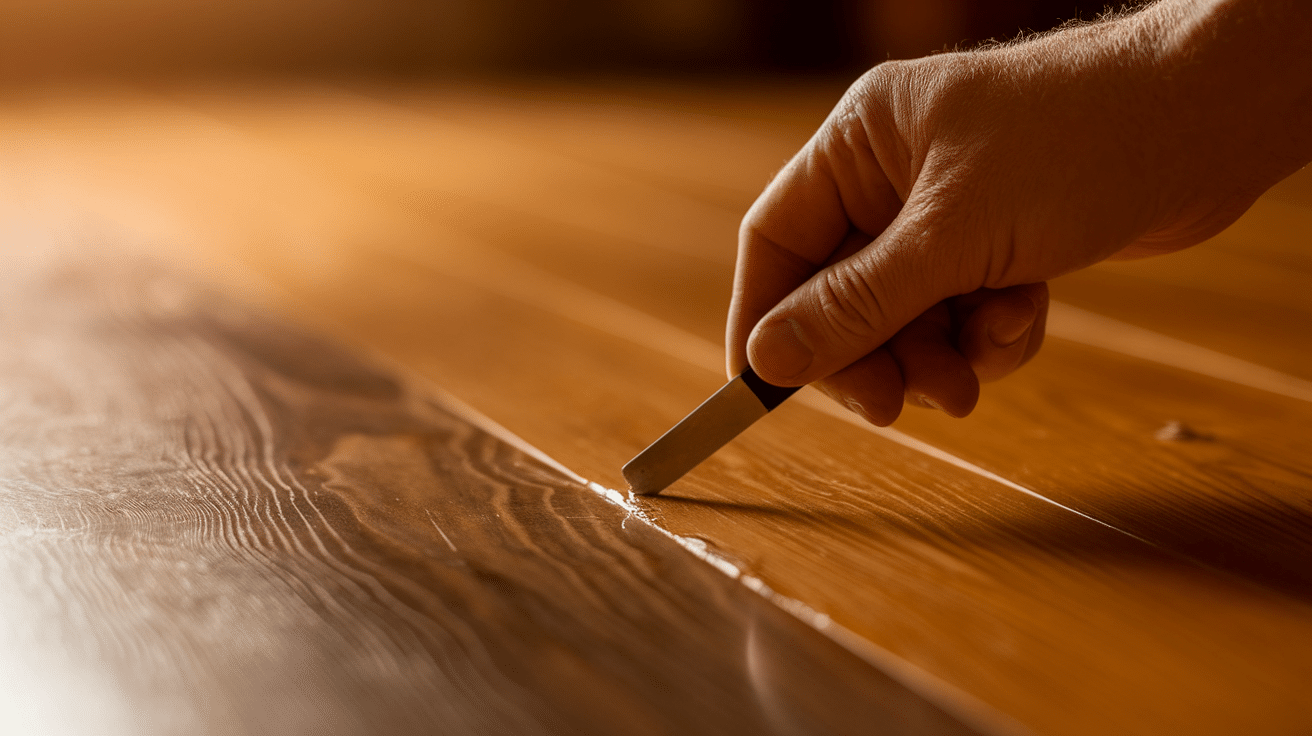Does your hardwood floor have scratches, gaps, or holes that catch your eye every time you walk by? These small flaws can make even the most beautiful floors look worn and old.
Many homeowners struggle to find the right wood filler that matches their floor color, dries quickly, and lasts for years without cracking or shrinking.
Good news: with the right wood filler, you can fix these issues yourself and make your floors look new again. The proper product will blend with your floor’s color and texture while standing up to foot traffic.
Ready to learn which wood fillers work best for different types of hardwood floor repairs? This guide will show you the top options, how to use them, and which ones give the most long-lasting results.
What is Wood Filler and Why Does It Matter?
Wood filler is a paste-like substance used to fix small flaws in wood surfaces. It’s made of sawdust, wood fibers, or cellulose mixed with a binding agent. When dry, you can sand and finish it just like natural wood.
Hardwood floors often show wear in the form of:
- Small cracks between boards
- Nail holes from past repairs
- Gaps that form as wood shrinks
- Dents from dropped items or furniture
These issues may seem minor, but they can make your floor look old and worn. They also collect dirt and may grow bigger over time. Wood filler helps solve these problems by filling in these spots to create a smooth, even surface.
Picking the right filler is key. The filler should match both your wood type and color.
Pine floors need different fillers than oak or maple. The color must blend with your floor’s tone to make repairs less noticeable. Some fillers can be stained, while others come pre-colored for easier matching.
A good wood filler fix can make floors look fresh and well-kept without the cost of full floor replacement.
Types of Wood Fillers for Hardwood Floors
1. Water-Based Fillers
Water-based fillers dry fast and clean up with soap and water. They’re good for the home since they have few harsh smells. These work well for:
- Quick fixes of small holes
- Shallow scratches
- Tiny gaps between boards
2. Oil-based Fillers
Oil-based options take longer to dry but offer more staying power. They stand up better to foot traffic and wear. Use these for:
- Wider cracks
- High-traffic spots in your home
- Areas that need extra strength
3. Epoxy Fillers
Epoxy creates the toughest bond of all fillers. Once dry, it’s almost as strong as the wood itself. Perfect for:
- Deep holes
- Edges of stairs
- Areas with water exposure
- Spots that bear weight
4. Powdered Fillers
These come as dry powder you mix with water. The big plus? You control how thick or thin the mix is. Great for:
- Custom color matching
- Filling sawdust with glue for perfect color
- Making just the amount you need
Top 5 Best Wood Fillers for Hardwood Floors in 2025
These wood fillers stand out from the crowd with their quality, ease of use, and lasting results for your hardwood floor repair needs.
1. Minwax High Performance Wood Filler
This wood filler bonds firmly to your floor and works well for both small and large fixes. It dries hard enough to be sanded smooth and takes stain well, making it hard to spot once your repair is done. Users praise how it doesn’t pull away from the edges of the repair as it dries.
- Started in 1904 as a maker of floor waxes and polishes
- Gained fame for their wood stains in the 1950s
- Added wood fillers to their line in the 1970s
Buying Advice: Buy the smallest size that meets your needs—this filler dries out in the can once opened.
2. Elmer’s Carpenter’s Wood Filler
Elmer’s offers a smooth, creamy filler that spreads easily into cracks and holes. It dries in about 24 hours and sands down to match your floor’s surface. The water-based formula makes cleanup simple with just soap and water.
- The company began in 1947 with their famous white glue
- Added wood fillers to their product line in the 1960s
- Known for making products safe for home and school use
Buying Advice: The light color takes stain well, but test it first on a hidden spot of your floor.
3. DAP Plastic Wood X
This filler stays put in your repair without shrinking back as it dries. It’s tough enough for spots that get lots of foot traffic and won’t crack over time. DAP’s filler also dries fast, letting you finish your floor repair in one day.
- Founded in 1865 as a maker of sealing wax
- Began making wood fillers in the early 1900s
- Now offers over 300 home repair products
Buying Advice: This filler dries faster than most—have all your tools ready before you start.
4. J-B Weld Wood Restore Repair Kit
This two-part epoxy system fills even the deepest floor damage with a rock-hard repair. It won’t shrink or pull away from the sides of the hole, and it stands up to heavy use once cured. The kit form lets you mix just what you need for each job.
- Started in 1969 with metal repair epoxy
- Added wood repair products in the 1990s
- All products made in the USA
Buying Advice: Work in small batches—once mixed, you have limited time before it hardens.
5. FamoWood Wood Filler
FamoWood makes fillers in many wood tones to match your floor’s color. It dries solid and holds screws if needed for later repairs. This filler works well for both tiny splits and wider gaps between boards.
- Created in 1975 by lumber yard pros
- First to offer pre-colored wood fillers
- Now makes 15 wood-toned fillers
Buying Advice: The stainable version looks more natural than pre-colored for most jobs.
Maintenance Tips for Wood Floors After Filling
1. Keeping your hardwood floors looking pristine after repairs
- Allow filled areas to cure fully for 24 hours before walking on them
- Apply a matching sealer or finish over repairs to protect and blend them
- Keep pets with long nails away from newly repaired areas for several days
2. Regular maintenance and care to prevent further damage
- Clean floors weekly with a soft broom or vacuum using the bare floor setting
- Install felt pads under all furniture legs to prevent new scratches and dents
- Maintain indoor humidity between 35-55% using humidifiers or dehumidifiers
3. When to reapply filler and how to spot early signs of damage
- Inspect repairs every 3-6 months for signs of shrinkage or cracking
- Look for filler that has pulled away from the edges of the repair area
- Reapply filler immediately if you notice it sinking below the floor surface
7 Common Mistakes While Buying Wood Fillers
- Choosing a filler based on price alone rather than matching it to your specific floor type
- Buying water-based filler for deep repairs when oil-based or epoxy would be more durable
- Selecting a non-stainable filler when you need to match existing wood stain colors
- Purchasing too small an amount, forcing mid-project store runs when you run out
- Getting quick-dry formulas for large projects when you need more working time
- Buying pre-colored fillers without checking them against your actual floor in natural light
- Selecting indoor-only fillers for floors that may be exposed to moisture or temperature changes
Conclusion
Fixing hardwood floors with the right wood filler can save you money and keep your floors looking great for years. We’ve looked at the different types of fillers, top brands, and how to care for your floors after repairs.
Remember that matching your filler to your specific needs is key. Consider the size of the damage, the wood type, and the amount of foot traffic the area gets.
Once you’ve made your repairs, good maintenance will help them last longer. Regular cleaning, humidity control, and quick action on new damage will protect your investment.
With the tips in this guide, you can tackle most floor repairs yourself. Your floors will look better, last longer, and remain a beautiful part of your home for many years.
What floor repair project will you take on first?













